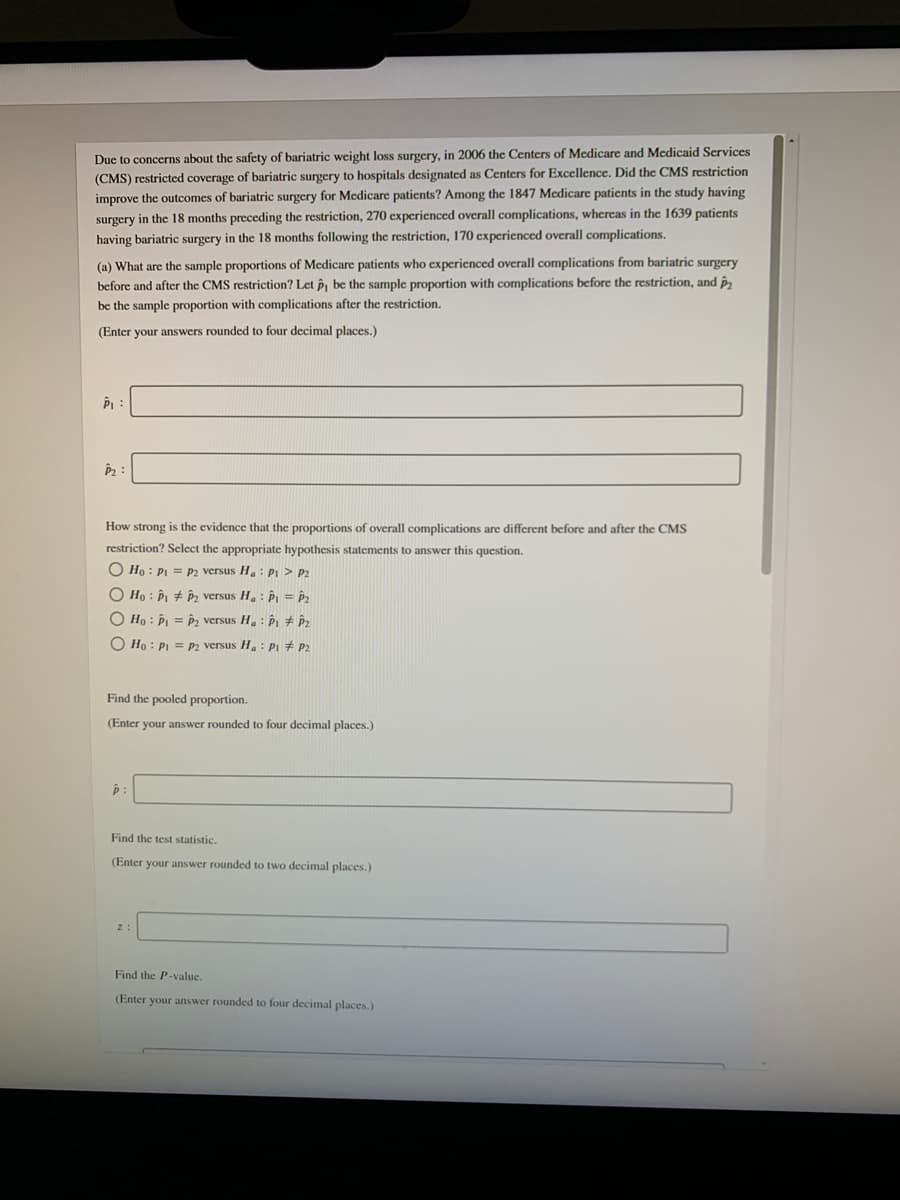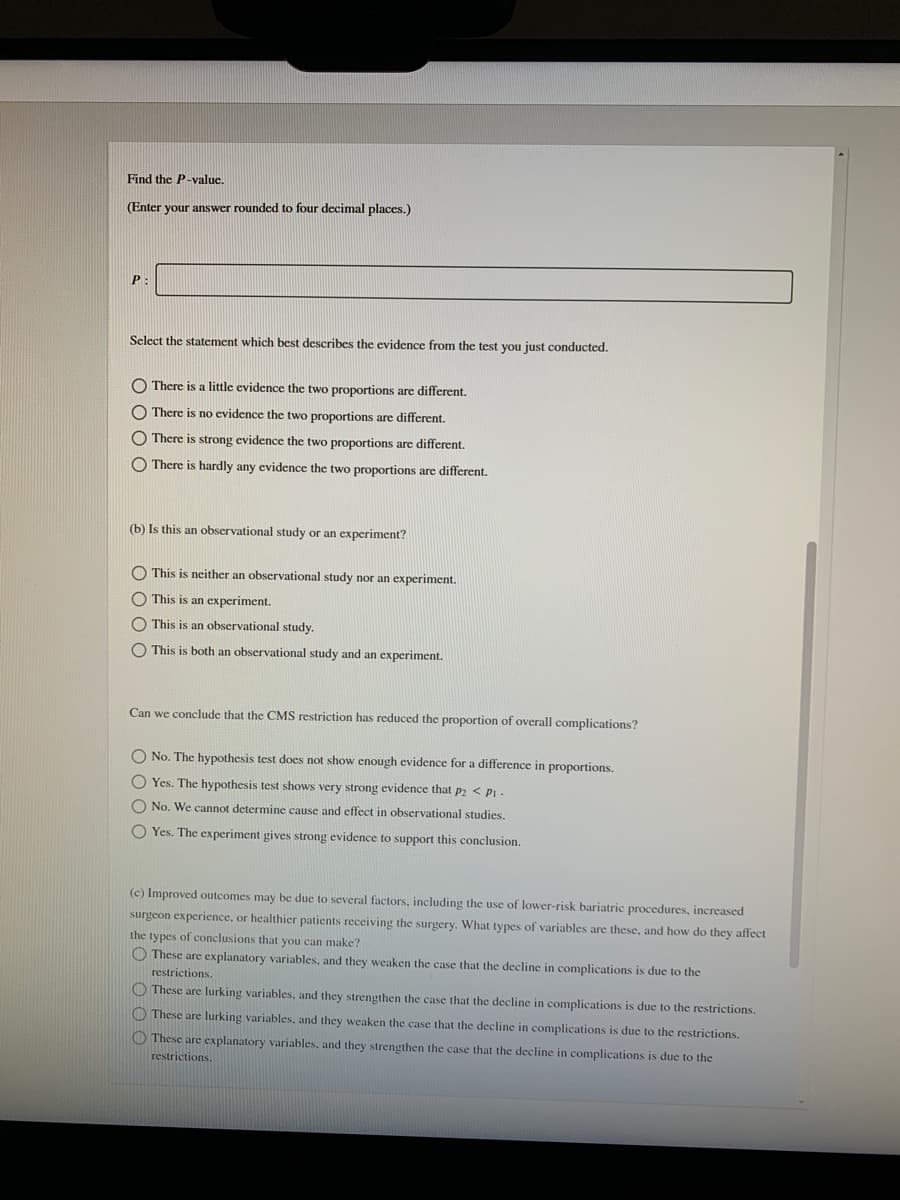Due to concerns about the safety of bariatric weight loss surgery, in 2006 the Centers of Medicare and Medicaid Scrvices (CMS) restricted coverage of bariatric surgery to hospitals designated as Centers for Excellence. Did the CMS restriction improve the outcomes of bariatric surgery for Medicare patients? Among the 1847 Medicare patients in the study having surgery in the 18 months preceding the restriction, 270 experienced overall complications, whereas in the 1639 patients having bariatric surgery in the 18 months following the restriction, 170 experienced overall complications. (a) What are the sample proportions of Medicare patients who experienced overall complications from bariatric surgery before and after the CMS restriction? Let p, be the sample proportion with complications before the restriction, and p be the sample proportion with complications after the restriction. (Enter your answers rounded to four decimal places.) P2 How strong is the evidence that the proportions of overall complications are different before and after the CMS restriction? Sclect the appropriate hypothesis statements to answer this question. O Ho : PI = P2 versus H. : Pi > P2 O Ho : PI # P2 versus H, : P, = P2 O Ho : PI = P2 versus H: P # P2 Ho: Pi = P2 versus H: Pi + P2 Find the pooled proportion. (Enter your answer rounded to four decimal places.) Find the test statistic. (Enter your answer rounded to two decimal places.) Find the P-value. (Enter your answer rounded to four decimal places.)
Due to concerns about the safety of bariatric weight loss surgery, in 2006 the Centers of Medicare and Medicaid Scrvices (CMS) restricted coverage of bariatric surgery to hospitals designated as Centers for Excellence. Did the CMS restriction improve the outcomes of bariatric surgery for Medicare patients? Among the 1847 Medicare patients in the study having surgery in the 18 months preceding the restriction, 270 experienced overall complications, whereas in the 1639 patients having bariatric surgery in the 18 months following the restriction, 170 experienced overall complications. (a) What are the sample proportions of Medicare patients who experienced overall complications from bariatric surgery before and after the CMS restriction? Let p, be the sample proportion with complications before the restriction, and p be the sample proportion with complications after the restriction. (Enter your answers rounded to four decimal places.) P2 How strong is the evidence that the proportions of overall complications are different before and after the CMS restriction? Sclect the appropriate hypothesis statements to answer this question. O Ho : PI = P2 versus H. : Pi > P2 O Ho : PI # P2 versus H, : P, = P2 O Ho : PI = P2 versus H: P # P2 Ho: Pi = P2 versus H: Pi + P2 Find the pooled proportion. (Enter your answer rounded to four decimal places.) Find the test statistic. (Enter your answer rounded to two decimal places.) Find the P-value. (Enter your answer rounded to four decimal places.)
Glencoe Algebra 1, Student Edition, 9780079039897, 0079039898, 2018
18th Edition
ISBN:9780079039897
Author:Carter
Publisher:Carter
Chapter4: Equations Of Linear Functions
Section: Chapter Questions
Problem 8SGR
Related questions
Question

Transcribed Image Text:Due to concerns about the safety of bariatric weight loss surgery, in 2006 the Centers of Medicare and Medicaid Services
(CMS) restricted coverage of bariatric surgery to hospitals designated as Centers for Excellence. Did the CMS restriction
improve the outcomes of bariatric surgery for Medicare patients? Among the 1847 Medicare patients in the study having
surgery in the 18 months preceding the restriction, 270 experienced overall complications, whereas in the 1639 patients
having bariatric surgery in the 18 months following the restriction, 170 experienced overall complications.
(a) What are the sample proportions of Medicare patients who experienced overall complications from bariatric surgery
before and after the CMS restriction? Let p, be the sample proportion with complications before the restriction, and p,
be the sample proportion with complications after the restriction.
(Enter your answers rounded to four decimal places.)
P2
How strong is the evidence that the proportions of overall complications are different before and after the CMS
restriction? Sclect the appropriate hypothesis statements to answer this question.
O Ho : PI = p2 versus H.: Pi > P2
O Ho : P, # p, versus H. : P = P2
O Ho : P = , versus H. : P # P2
O Ho : PL = p2 versus H : PL # P2
Find the pooled proportion.
(Enter your answer rounded to four decimal places.)
Find the test statistic.
(Enter your answer rounded to two decimal places.)
Find the P-value.
(Enter your answer rounded to four decimal places.)

Transcribed Image Text:Find the P-valuc.
(Enter your answer rounded to four decimal places.)
P:
Select the statement which best describes the evidence from the test you just conducted.
O There is a little evidence the two proportions are different.
O There is no evidence the two proportions are different.
O There is strong evidence the two proportions are different.
O There is hardly any evidence the two proportions are different.
(b) Is this an observational study or an experiment?
O This is neither an observational study nor an experiment.
O This is an experiment.
O This is an observational study.
O This is both an observational study and an experiment.
Can we conclude that the CMS restriction has reduced the proportion of overall complications?
O No. The hypothesis test does not show enough evidence for a difference in proportions.
O Yes. The hypothesis test shows very strong evidence that p2 < Pi-
O No. We cannot determine cause and effect in observational studies.
O Yes. The experiment gives strong evidence to support this conclusion.
(c) Improved outcomes may be due to several factors, including the use of lower-risk bariatric procedures, increased
surgeon experience, or healthier patients receiving the surgery. What types of variables are these, and how do they affect
the types of conclusions that you can make?
O These are explanatory variables, and they weaken the case that the decline in complications is due to the
restrictions,
O These are lurking variables, and they strengthen the case that the decline in complications is due to the restrictions.
O These are lurking variables, and they weaken the case that the decline in complications is due to the restrictions.
O These are explanatory variables, and they strengthen the case that the decline in complications is due to the
restrictions.
Expert Solution
This question has been solved!
Explore an expertly crafted, step-by-step solution for a thorough understanding of key concepts.
This is a popular solution!
Trending now
This is a popular solution!
Step by step
Solved in 3 steps

Knowledge Booster
Learn more about
Need a deep-dive on the concept behind this application? Look no further. Learn more about this topic, statistics and related others by exploring similar questions and additional content below.Recommended textbooks for you

Glencoe Algebra 1, Student Edition, 9780079039897…
Algebra
ISBN:
9780079039897
Author:
Carter
Publisher:
McGraw Hill

Glencoe Algebra 1, Student Edition, 9780079039897…
Algebra
ISBN:
9780079039897
Author:
Carter
Publisher:
McGraw Hill